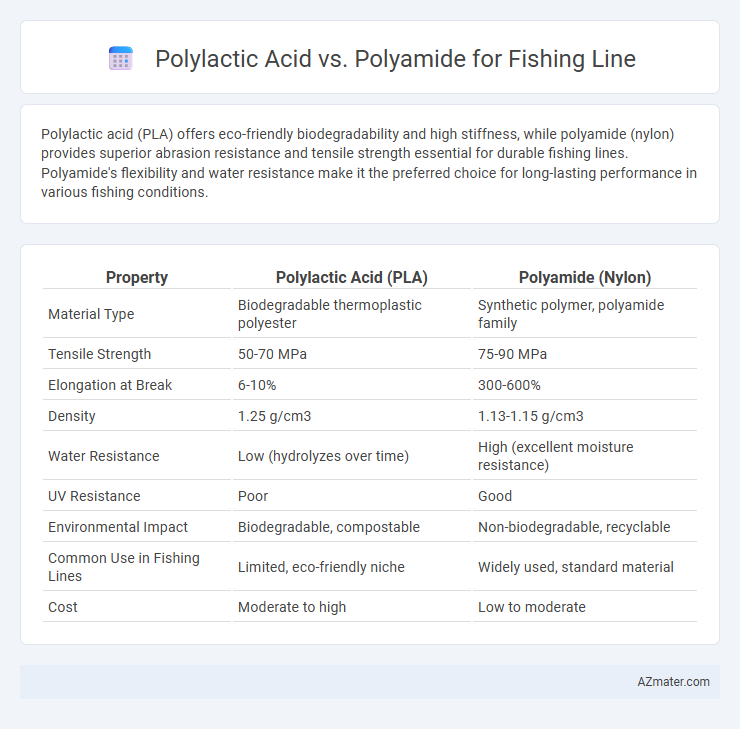Polylactic acid (PLA) offers eco-friendly biodegradability and high stiffness, while polyamide (nylon) provides superior abrasion resistance and tensile strength essential for durable fishing lines. Polyamide's flexibility and water resistance make it the preferred choice for long-lasting performance in various fishing conditions.
Table of Comparison
| Property | Polylactic Acid (PLA) | Polyamide (Nylon) |
|---|---|---|
| Material Type | Biodegradable thermoplastic polyester | Synthetic polymer, polyamide family |
| Tensile Strength | 50-70 MPa | 75-90 MPa |
| Elongation at Break | 6-10% | 300-600% |
| Density | 1.25 g/cm3 | 1.13-1.15 g/cm3 |
| Water Resistance | Low (hydrolyzes over time) | High (excellent moisture resistance) |
| UV Resistance | Poor | Good |
| Environmental Impact | Biodegradable, compostable | Non-biodegradable, recyclable |
| Common Use in Fishing Lines | Limited, eco-friendly niche | Widely used, standard material |
| Cost | Moderate to high | Low to moderate |
Introduction to Fishing Line Materials
Fishing line materials significantly impact strength, flexibility, and environmental footprint, with polylactic acid (PLA) and polyamide serving distinct roles. PLA, derived from renewable resources, offers biodegradability and stiffness but lacks the durability of conventional polyamide, which is prized for its high tensile strength and abrasion resistance. Choosing between PLA and polyamide involves balancing environmental sustainability against performance demands in various fishing conditions.
Overview of Polylactic Acid (PLA)
Polylactic Acid (PLA) fishing lines are derived from renewable resources like corn starch or sugarcane, offering a biodegradable alternative to traditional synthetic lines. PLA exhibits high tensile strength and excellent knot performance but has lower abrasion resistance compared to Polyamide, making it suitable for light to moderate fishing conditions. Its eco-friendly nature reduces environmental impact, promoting sustainability in fishing gear development.
Overview of Polyamide (Nylon)
Polyamide, commonly known as nylon, is a synthetic polymer widely used in fishing lines due to its exceptional strength, abrasion resistance, and elasticity. Its molecular structure provides high tensile strength and durability, making it ideal for withstanding the stresses of fishing environments. Polyamide fishing lines offer superior knot retention and resilience against UV damage, outperforming many biodegradable alternatives like polylactic acid in longevity and performance.
Strength and Durability Comparison
Polylactic acid (PLA) fishing lines offer moderate tensile strength but tend to degrade faster when exposed to UV light and moisture, limiting their long-term durability compared to polyamide options. Polyamide fishing lines, commonly known as nylon, provide superior strength with excellent abrasion resistance and elasticity, maintaining durability under harsh aquatic conditions. The enhanced durability and higher breaking strength of polyamide make it the preferred choice for demanding fishing applications requiring reliable performance.
Flexibility and Sensitivity Differences
Polylactic acid (PLA) fishing lines are more rigid and less flexible compared to polyamide lines, which offer superior flexibility crucial for smooth casting and effective lure action. In terms of sensitivity, polyamide lines excel due to their lower stiffness, allowing anglers to detect subtle bites and underwater movements more accurately. The enhanced flexibility and sensitivity of polyamide make it a preferred choice for anglers seeking precise control and responsiveness in various fishing conditions.
Environmental Impact and Biodegradability
Polylactic acid (PLA) fishing lines offer superior environmental benefits due to their compostable nature and ability to biodegrade under industrial composting conditions within months, significantly reducing ocean pollution. Polyamide (nylon) fishing lines, while durable and strong, persist in marine environments for decades, contributing to microplastic pollution and harming aquatic ecosystems. Choosing PLA over polyamide aligns with sustainable fishing practices by minimizing long-term environmental footprint and enhancing biodegradability.
Water Absorption and Performance
Polylactic acid (PLA) fishing lines exhibit higher water absorption rates compared to polyamide, leading to potential swelling and reduced tensile strength during prolonged water exposure. Polyamide's low water absorption enhances durability, maintaining consistent flexibility and performance even in humid or submerged conditions. This superior moisture resistance makes polyamide a preferred choice for fishing lines requiring long-term reliability and minimal degradation.
Knot Strength and Handling
Polylactic acid (PLA) fishing lines offer moderate knot strength but tend to be stiffer, impacting handling and making knots more prone to slipping under tension. Polyamide, commonly known as nylon, exhibits superior knot strength with excellent elasticity, allowing for secure knots that maintain integrity during fishing. The flexibility of polyamide enhances handling by providing smooth casting and reduced line memory, making it the preferred choice for anglers seeking reliable knot performance and ease of use.
Cost and Availability of PLA vs Polyamide
Polylactic acid (PLA) fishing lines are generally more affordable due to their bio-based production processes, but their availability remains limited compared to polyamide lines. Polyamide, commonly known as nylon, benefits from well-established manufacturing infrastructure, resulting in widespread accessibility and consistent supply worldwide. Cost efficiency of PLA can improve with scaling, yet polyamide retains an advantage in mass production and market presence.
Best Applications: Choosing the Right Fishing Line Material
Polylactic acid (PLA) fishing lines excel in eco-friendly, biodegradable applications, making them ideal for anglers prioritizing sustainability and reducing environmental impact. Polyamide fishing lines, commonly known as nylon, offer superior strength, abrasion resistance, and flexibility, which are essential for saltwater fishing and catching larger, more aggressive fish species. Selecting the right fishing line material depends on fishing conditions, target species, and environmental considerations, with PLA best suited for freshwater and light-duty use, while polyamide is preferred for durability and heavy-duty performance.

Infographic: Polylactic acid vs Polyamide for Fishing Line
 azmater.com
azmater.com